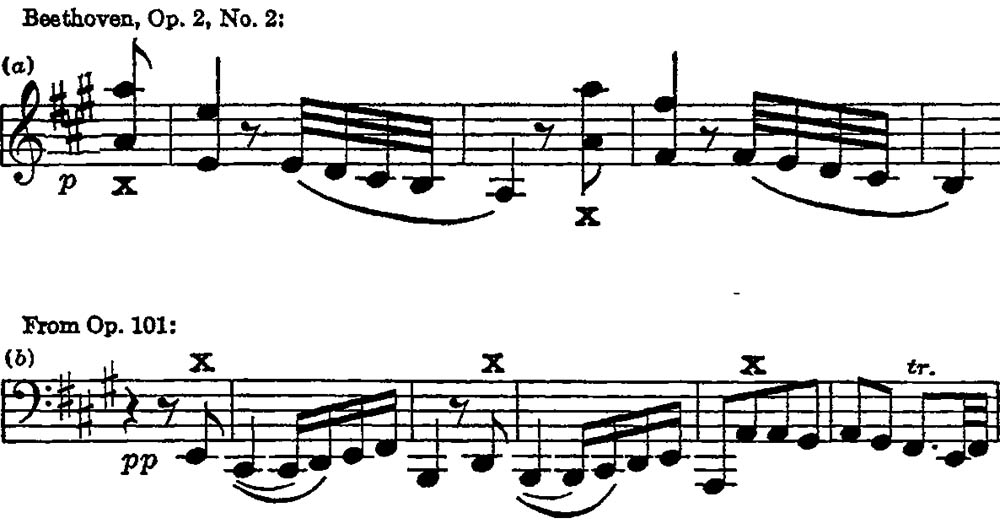Forearm down-force with Upper-arm Weight.
For fullest tone, both in singing passages and everywhere else, you need a still more substantial basis than the fullest arm-weight can supply, unaided. Here you must learn to add a down-exertion of the forearm to the previously discussed
momentary weight-release of the whole arm. That is, you must leave free the weight of the whole arm, while you nevertheless exert your Forearm downwards; that is*, a down-exertion of the Forearm in addition to this whole-arm Weight.
Use of the Forearm lever:
Note: This conjoint Forearm down-exertion with released Weight is needed for a certain penetrating singing-tone. Pure Weight-release does not suffice here. Use of the This exertion of the Forearm downwards is again quite a natural
Forearm lever action is really a lifting action, for it is similar to the natural use of the bannisters[1] as a help in mounting the stairs.
The shoulder, therefore, in this case becomes the Basis for your playing action it is lifted against, and thus, through your shoulder, the whole mass of your body (quietly resting on the chair) becomes the ultimate Basis.
The main secret of producing large tone without harshness lies in this down-exertion of the forearm in conjunction with a free upper-arm.
The main secret of producing large tone without harshness lies in this down-exertion of the forearm in conjunction with a free upper-arm.
Form of arm use to be avoided during Piano Playing
Finally, we see that a fourth optional form of arm-use is possible. It is one, however, that should be carefully avoided unless used very lightly.
Here, along with the down exertion of the forearm, you drive forwards with the upperarm, instead of leaving it lax. It feels like a horrible digging action into the keyboard with arm and elbow, and the elbow feels thoroughly rigid during its perpetration. This type of motion is to be avoided.
This last (and undesirable) form of arm-condition calls for more amplified consideration, as it forms one of the worst and most frequent causes of bad tone, and perhaps more often spoils musicality of effect than any of the many other possible forms of incorrect motions at the keyboard. It is only too frequently heard in the playing of otherwise quite good pianists, and even popular artists. Only keyboardists with sensitive hearing and an understanding of the playing mechanism avoid it consistently.
Here, along with the down exertion of the forearm, you drive forwards with the upperarm, instead of leaving it lax. It feels like a horrible digging action into the keyboard with arm and elbow, and the elbow feels thoroughly rigid during its perpetration. This type of motion is to be avoided.
This last (and undesirable) form of arm-condition calls for more amplified consideration, as it forms one of the worst and most frequent causes of bad tone, and perhaps more often spoils musicality of effect than any of the many other possible forms of incorrect motions at the keyboard. It is only too frequently heard in the playing of otherwise quite good pianists, and even popular artists. Only keyboardists with sensitive hearing and an understanding of the playing mechanism avoid it consistently.
Forward-drive occasionally appropriate :
This type of arm-combination nevertheless occasionally finds its use and should be avoided. Gently, it can be applied with good effect, for producing certain "dry" effects. For that comparatively rare effect, a true staccatissimo, it serves well and should be implemented gently. It is also responsible for certain special colour effects for instance, that gentle little knock, suggestive of distant " Horns," is produced in this way.Upper-arm forward for ppp :
This forward action of the upperarm can actually help us to obtain the very lightest effects. But in order to succeed in motion, we must carefully avoid any evidence of fore-arm down-drive with it, and must also eliminate almost all of the forearm weight.
Thus, when you lightly the upper-arm forward (away from you) you really lift its weight off the keyboard visibly or invisibly, as the case may be, and you can thus achieve lightness to any degree.
But do not overdo this trick, or else you will miss your notes.
Two example of foreward action of the upper arm
As two noteworthy instances of its application you will find that it is the only way of playing with certainty- the up-beat (the opening note) of Beethoven's Sonata in A, Op. 2;
- and also the first note of the Fugue in the last movement of his Sonata in A, Op. 101.

[1]bannister: The structure formed by the uprights and handrail at the side of a staircase.